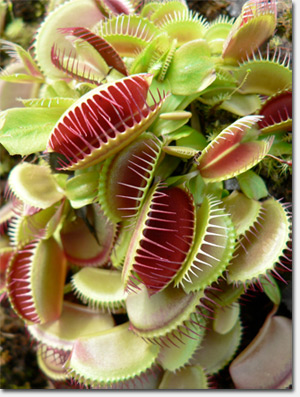 Early last month, CHOMP! 2 opened at the Conservatory of Flowers in Golden Gate Park. The original CHOMP! show debuted in 2007.
Early last month, CHOMP! 2 opened at the Conservatory of Flowers in Golden Gate Park. The original CHOMP! show debuted in 2007.
Named for the class of carnivorous plants that feast on insects and winged treats, CHOMP! showcases hundreds of multi-colored, meat-eating plants arranged in swampy, living bogs that display species both by their trapping strategies and by their native regions and countries.
I stopped in last weekend to check out CHOMP! and learned a lot about these complex plants and their unique survival skills. There were several types of pitcher plants on display, most of which produce enzymes to digest their prey. But the Cobra Plant, another pitcher variety, relies instead on bacteria and small organisms to break down its meal.
In addition to their treacherous trap, the Nepenthese pitcher plant also has medicinal value. Its pitcher is full of sterile liquid that can be used to clean wounds or even to drink. In Southeast Asia, the Nepenthese pitchers are filled with rice and placed in a pot of boiling water; locals say the rice tastes better that way.
Some of the plant’s trapping mechanisms are quite small, so there are magnifying glasses on hand to give you a closer look. Unlike Channel 7’s Don Sanchez in the video below, visitors are asked not to set off the Venus flytraps with pens or other objects. If a flytrap is triggered when there is no real food, it can lead to the plant’s death since their feeding system is on an internal timer.
If you’re think you’re man enough to handle these carnivorous plants, you can even leave the Conservatory with one tucked under your arm. Ranging from $5 to $16, the gift shop sells a variety of the plants seen in the CHOMP! show, including Venus Flytraps, Sundews, Butterworts, and even Nepenthese.
Looking for more meat eaters? Sebastapol is home to the world’s largest carnivorous plant nursery, California Carnivores. Owner Peter D’Amato will be at the Conservatory on July 14 for a special lecture, “The Savage Garden: An Introduction to Carnivorous Plants”.
During my visit I also checked out the Chinese Penjing or “tray scenery”, which date back more than 2000 years and are the ancestors of Japan’s Bonsai tradition. The exhibit includes this interesting story about the use of the decorative scenes:
It is said that the Emperor of China didn’t travel a lot. His emissaries would go out and collect stones from the landscapes of various regions to make these creations to illustrate what his realm looked like.
I always enjoy a visit to the Conservatory, whether it’s to check out a new exhibition or to see the gorgeous orchids and other blooming plants. The Conservatory of Flowers is open Tuesday through Sunday from 10am to 4pm; the CHOMP! exhibit will be open until October 31.
Sarah B.